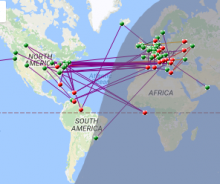Reverse Beacon Network and I/Q Recording Guides Updated
Reverse Beacon Network and I/Q Recording Guides Updated

During the Solar Eclipse QSO Party, we'll be collecting data from the Reverse Beacon Network, a system which uses wideband SDR-based receivers called "skimmers" to decode CW and RTTY signals in large parts of the amateur HF spectrum and send decoded callsigns to a central server. During the contest, we'd like to have as many skimmers in operation as possible, as each skimmer adds another point of data. We'd also like skimmer operators to record the digitized RF data being captured by their receivers for later analysis by the HamSCI researches to spot unusual signal characteristics after the contest.
We've added new guides on how to run Reverse Beacon Network nodes on common SDRs. If you have a Red Pitaya, QS1R, or FLEX-6000 series SDR, it's easy to set up your radio to skim several bands at once and send spots to the RBN. And you can record the data that's being skimmed, even while the skimmer is operating! See our guides for skimming and recording on the Red Pitaya, QS1R, and FLEX series radios to get started. Other SDRs can be made to work also - if your SDR can send wideband I/Q data to CW Skimmer, it can work with the RBN.
